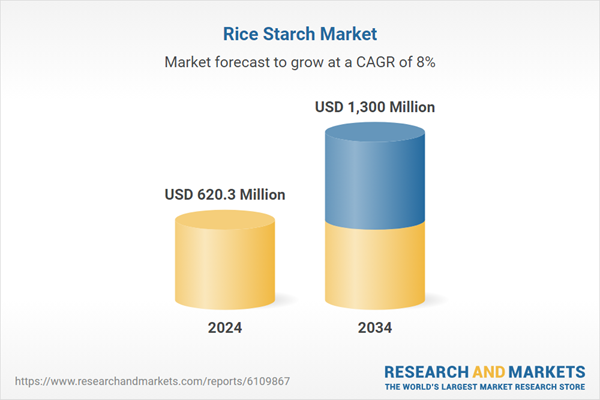Additionally, new and innovative uses emerging within traditionally slower-growing segments are poised to contribute significantly to the rice starch market’s overall expansion. These developing applications create fresh demand streams that complement and strengthen the momentum seen in faster-growing industries. By diversifying the range of end-use cases, such as specialized pharmaceutical formulations, advanced cosmetic products, and niche food applications, these emerging sectors help stabilize growth and open opportunities for cross-industry integration. This broader adoption not only drives incremental volume but also encourages investment in research and development, fueling product innovation and enabling manufacturers to tap into previously untapped markets.
In 2024, the native rice starch segment held a valuation of USD 309.4 million and is anticipated to grow at a CAGR of 7.9% through 2034. Native rice starch continues to dominate the market due to its extensive use across various industries. It is especially favored because of its milled-derived form, versatility, and alignment with clean-label requirements. The food and beverage industry represents the largest consumer base for native rice starch, leveraging its thickening, gelling, and stabilizing functions in products such as dairy, sauces, and infant nutrition. Its natural origin and functional benefits make it an essential ingredient in many formulations.
The white rice type segment accounted for USD 267.4 million in 2024 and is expected to grow at an 8.1% CAGR through 2034, holding a 43.1% share. White rice remains the leading source of rice starch, thanks to its ease of processing, abundant availability, and neutral flavor profile. Both consumers and manufacturers prefer rice starch derived from white rice due to its consistent, high-quality yield, making it ideal for use in food, pharmaceutical, and cosmetic products that demand superior starch quality. Large-scale producers also favor white rice because of its standardized properties and efficient extraction methods. Additionally, rising interest in organic and minimally processed foods is boosting the demand for rice starch from white rice, which is increasingly perceived as a premium ingredient.
U.S. Rice Starch Market was valued at USD 167.5 million in 2024 and is expected to grow at a 7.8% CAGR from 2025 to 2034. Growth in the U.S. is attributed to the rising preference for clean-label, gluten-free, and plant-based ingredients. The food and beverage industry continues to be the dominant consumer, particularly within bakery, dairy, and convenience food applications. Demand is also increasing in the pharmaceutical and cosmetics sectors due to rice starch’s hypoallergenic and biodegradable properties. Advances in processing technologies have enhanced product quality and expanded the range of applications, further strengthening market growth. The U.S. stands as the most active market player in North America, driving growth across the region.
On a global scale, the Rice Starch Market is moderately consolidated, with major players such as Roquette Frères, Cargill Incorporation, BENEO GmbH, AGRANA Beteiligungs-AG, and Ingredient Incorporated leading the competition. These companies hold significant market shares and are instrumental in shaping industry trends. Leading companies in the rice starch market adopt various strategic initiatives to strengthen their market position. They focus heavily on innovation, developing new formulations and processing techniques that enhance product functionality and meet clean-label demands. Strategic partnerships and collaborations with food and beverage manufacturers help expand their distribution networks and end-use applications. Investment in sustainable sourcing and production practices reinforces their commitment to environmental responsibility, which appeals to eco-conscious consumers.
Comprehensive Market Analysis and Forecast
- Industry trends, key growth drivers, challenges, future opportunities, and regulatory landscape
- Competitive landscape with Porter’s Five Forces and PESTEL analysis
- Market size, segmentation, and regional forecasts
- In-depth company profiles, business strategies, financial insights, and SWOT analysis
This product will be delivered within 2-4 business days.
Table of Contents
Companies Mentioned
- A&B Ingredients
- AGRANA Beteiligungs-AG
- Agrana Group
- Anhui Lianhe
- Archer Daniels Midland Company
- Bangkok Starch Industrial Co., Ltd.
- Beneo (Südzucker Group)
- Cargill, Incorporated
- Golden Agriculture Co., Ltd.
- Herba Ingredients
- Hunan ER-KANG
- Ingredion Incorporated
- Jiangxi Golden Agriculture Co., Ltd.
- Roquette Frères
- Shaanxi Tianyu Pharmaceutical Co., Ltd.
- Sonish Starch Technology Co., Ltd.
- Tate & Lyle PLC
- THAI WAH PUBLIC COMPANY LIMITED
- Thai Flour Industry Co., Ltd.
- Wuxi Chuangda Food Co., Ltd.
Table Information
| Report Attribute | Details |
|---|---|
| No. of Pages | 235 |
| Published | June 2025 |
| Forecast Period | 2024 - 2034 |
| Estimated Market Value ( USD | $ 620.3 Million |
| Forecasted Market Value ( USD | $ 1300 Million |
| Compound Annual Growth Rate | 8.0% |
| Regions Covered | Global |
| No. of Companies Mentioned | 20 |









